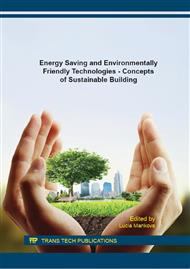p.299
p.307
p.315
p.323
p.331
p.339
p.347
p.355
p.363
The Applicability of Existing Methods for Testing the Base Layers of ETICS
Abstract:
The contact thermal insulation system is a major trend in building construction in the Czech Republic. In this way both for new buildings and for renovations to improve thermal and technical parameters of buildings. Effort of an extension of the construction season, however, causes frequent visits of the application of this system in unsuitable weather conditions. One of the important layers in the systems ETICS (which is the contact thermal insulation of the building) is the basic layer with glass-fibre reinforcing mesh. Such a cover layer of thermal insulation and at the same time a basis for the final outer layer - plaster. Climatic conditions during application are given by the manufacturer. Normal temperature is indicated by + 5°C to +30°C. The lower boundary is not often observed. That's why I have my research and thesis focused on testing the parameters of the base layer made outside the ideal conditions. I thus produced samples underwent laboratory tests and watching the resulting parameters. This article provides a brief description of the testing methods and their advantages and disadvantages. The methods used were, for example, tests in flexural strength, pressure, water absorption test or tests of beginning and end of solidification. The most important findings of my research were the facts that significantly limit the applicability of standardized tests to determine the beginning and end of solidification. For the base layer samples of 4mm even these methods give very distorted information. Another effort of my research will be to verify these results and determine how it will be necessary to modify the methodology of testing, we received the relevant data. Preliminary hypothesis is at least the size of a substitute specimens - especially reducing the sample thickness from 40 mm to 4-6 mm, which corresponds to the reality of practical implementation. The data obtained would subsequently be used to adjust the rules for testing insulation systems. Data were obtained primarily from my research within VUT FAST brand FAST‑J‑10‑50
Info:
Periodical:
Pages:
331-338
Citation:
Online since:
January 2016
Authors:
Price:
Сopyright:
© 2016 Trans Tech Publications Ltd. All Rights Reserved
Share:
Citation:


